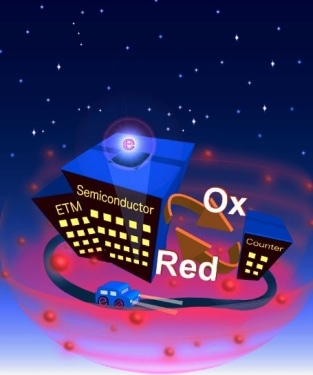Jul 18 2019
Researchers at Tokyo Institute of Technology and Sanoh Industrial created a very stable battery cell with the potential to directly turn heat into electricity, thus ultimately offering a method for making use of geothermal energy in a sustainable manner.
 Operation of the thermal cell. (Image credit: Tokyo Institute of Technology)
Operation of the thermal cell. (Image credit: Tokyo Institute of Technology)
The development of new energy-generation technologies is the only hope in this world of increasing energy consumption. While existing renewable energy sources like solar energy and wind have their advantages, there is obviously a huge, permanent, and untapped energy source: geothermal energy.
Devices that can somehow exploit the heat within the Earth’s crust are needed to generate electricity from geothermal energy. Recently, a group of researchers from Tokyo Tech, headed by Dr Sachiko Matsushita, has achieved a significant advancement in the understanding and development of sensitized thermal cells (STCs), a type of battery that can produce electric power at 100 ○C or below.
There are a number of techniques for converting heat into electric power; however, their large-scale application is not viable. For example, it is not possible to just bury hot-and-cold redox batteries and devices based on the Seebeck effect inside a heat source and make use of them.
Dr Matsushita’s team had earlier presented the use of STCs as a new technique for converting heat directly into electric power using dye-sensitized solar cells. In addition, they replaced the dye with a semiconductor to enable the system to function using heat rather than light.
The STC battery contains three layers sandwiched between electrodes: a semiconductor layer (germanium), an electron transport layer (ETM), and a solid electrolyte layer (copper ions). In a nutshell, electrons move from a low-energy state to a high-energy state in the semiconductor by becoming thermally excited and subsequently get transferred naturally to the ETM.
Next, they leave through the electrode, move through an external circuit, penetrate the counter electrode, and subsequently reach the electrolyte. Reduction and oxidation reactions involving copper ions occur at both interfaces of the electrolyte, leading to low-energy electrons being shifted to the semiconductor layer so that the process can start anew, thereby completing an electric circuit.
However, at that time, it was not apparent if such a battery could be used as a perpetual engine or if the current would stop at some point. After testing, the group noticed that electricity actually stopped flowing after a particular time and put forward a mechanism describing this phenomenon.
Fundamentally, current stops as the redox reactions at the electrolyte layer stop due to the relocation of the various kinds of copper ions. Most essentially, and also astonishingly, they discovered that the battery can revert this condition itself in the presence of heat by just opening the external circuit for some time, or simply put, by using a simple switch.
With such a design, heat, usually regarded as low-quality energy, would become a great renewable energy source.
Dr Sachiko Matsushita, Tokyo Institute of Technology
The group is very thrilled about their discovery due to its eco-friendliness, applicability, and capability for helping solve the global energy crisis. “There is no fear of radiation, no fear of expensive oil, no instability of power generation like when relying on the sun or the wind,” remarks Matsushita.
Further enhancements to this kind of battery will be the objective of future research, with the hope of solving humanity’s energy requirements without affecting the planet someday.